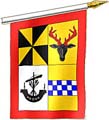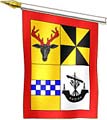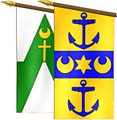| |
National Flags:
The Union flag is the correct flag flown by citizens and corporate
bodies wishing to show their loyalty to the United Kingdom. This
should not be flown upside down. The broader white diagonals are
uppermost in the hoist. The Scottish Saltire, blue with its white
diagonal cross, is the flag of St Andrew, patron saint of Scotland. It
is the correct flag for Scots or Scottish corporate bodies to fly to
demonstrate their loyalty and nationality. It is quite correct to fly
it alone or together with the Union flag. Since the Royal Navy
introduced flags of a length twice their height it has become common
to use British national flags of these proportions. However it is not
necessary to fly these national flags in these proportions. Regimental
colours for instance, are in a length to height ratio of 5 to 4, a
much more comfortable shape to carry on a banner staff and where
national flags are to be flown alongside square heraldic banners, they
may also be square. |
|
| |
|
 |
| The St
Andrews flag, Scotland |
|
 |
| The
flag of the Heraldry Society of Scotland |
|
 |
| The
Union Jack flag of the United Kingdom |
|
|
|
| |
The Heraldic Banner:
This is the personal flag of an armiger which shows the arms, as
depicted on the shield, and nothing else. Conventionally, the design
is placed on the flag as if the flagstaff were to the left of a
drawing of the shield. Thus, a rampant animal is said to 'respect' the
staff, an eagle displayed looks towards the staff and so on. The
design should go through the fabric so that on the reverse side all
the devices will be turned about but will still respect the staff. It
is quite wrong to use a banner of a plain colour with the owners arms
on a shield in the middle. This implies that the arms are of that
colour with a small inescutcheon in the centre. It is equally wrong to
show the helmet, crest, motto and supporters on a banner.
The purpose of a banner is to locate and identify its owner and it is
the visual equivalent of his name. Flown over his house, it identifies
his property, elsewhere, it indicates his presence. The size of a
house banner will depend on the height of the building and the pole.
It should be large enough to be identified from a reasonable distance.
The best shape for a heraldic house flag is square, regardless of its
size. A smaller banner or Parade banner is designed to be carried in
processions, either by its owner or by his appointed banner bearer.
Such a banner is usually made in fine fabric and may be fringed. Its
proportions should be those of an upright rectangle about five wide by
six deep. |
|
| |
The Pipe Banner
When an armiger has appointed a personal piper, he may provide him
with a banner to be attached to the base drone of the pipes. The same
applies to an armigerous corporation. and where such a body has a pipe
band, the pipe major attaches the banner to his pipes. The pipe banner
may take various forms but is always shaped with an angle at the top
corresponding approximately to the angle of the drone on the piper
shoulder. It then hangs down behind him and may end in a swallow tail,
a double rounded end or any other way suited to the arms. The arms
themselves are shown in the same manner as on a personal banner but
are commonly turned so that they are right way up when the pipes are
being played. A certain amount of distortion is allowed to enable the
artist to fit the arms into the odd shape
Pipe banners are also much used in the Highland regiments, where each
company commanders' arms are borne on the pipes of the regimental
band. Each regiment has its own tradition for the display of the arms
and the regimental badge and these traditions are so well established
as to have become acceptable even when they do not conform to the
strict rules of heraldry. A pipe banner may have a different design on
either side and in this case it needs to be rendered opaque by
including a layer of black fabric between the two sides. A fringe may
be added to any pipe banner, either plain or of the appropriate
tartan.
The Trumpet Banner
Rarely now called for, the trumpet banner consists of an approximately
square banner of the arms, usually in very rich materials, fringed and
tasselled according to taste and suspended from the trumpet by ribbons
or straps. The arms are placed in such a way that the charges are
right way up and facing away from the trumpeter when he is playing.
The Street Banner
Where the only available flagstaff is attached to the facade of a
building, the usual house flag is sometimes unsuitable The design is
often obscured due to its being at an angle or the flag is partly
furled when there is no wind or blown over the staff when the wind
eddies round the building. The street banner can be adapted to
overcome these difficulties. In shape, the street banner is very like
a large pipe banner. The charges upon it however should look outwards
away from the buildings. The heaviest fabric which is practical should
be employed and stiffeners may be sewn into the hems or fringes
attached to the staff. A smaller form of the street banner may also be
used for internal decoration as for example, in the great hall of a
castle. |
|
| |
|
|
 |
|
Street Banner of Alistair
|
|
Campbell of Airds, right
|
|
|
|
 |
|
Street Banner of
Alistair |
|
Campbell of Airds,
left |
|
|
|
 |
| Hall
Banners of |
| John
& Eilean Malden |
|
|
|
|
| |
The Gonfannon
Also known as a gonfalon, this is the form of banner often associated
with the church where it is used in processions. It's essential
feature is that it hangs from a horizontal bar which may in turn be
suspended from a carrying staff. Not all church gonfannons are
heraldic and many have highly decorated pictorial designs. Heraldic
gonfannons are particularly suited to the internal decoration of
historic buildings with arms appropriate to the people and events
associated with them. The gonfannon is capable of a variety of
interpretations, the simpler the better. A rectangular upright banner
of the arms with long tails of the livery colours is recommended. |
|
| |
|
|
 |
|
Gonfannon of Robert Lindsay |
| Earl
of Crawford & Balcarres |
|
|
|
 |
|
Gonfannon of Roman Catholic |
|
Diocese of Argyll and the Isles |
|
|
|
|
| |
The Livery Pennon
The livery pennon is a very simple flag consisting of the tinctures of
the field and principal charge in the arms arranged on a long streamer
parted horizontally and tapering to a point. Such a pennon has a
practical value as a storm flag when, in high winds and rain, an
expensive heraldic flag might quickly torn to ribbons. A number livery
pennons spaced along an avenue or around a games ground is an
economical means of heraldically based decoration. |
|
|
|
|